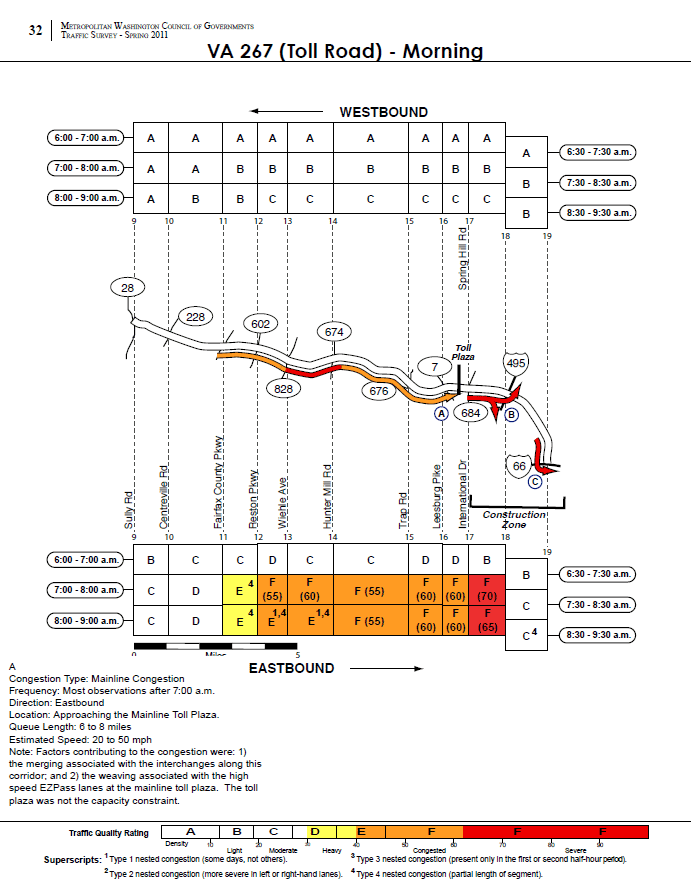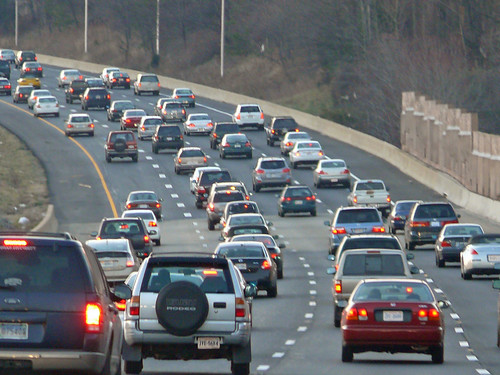How Will The Silver Line Impact The Region’s Traffic Hotspots?
The Silver Line will relieve traffic congestion on the Dulles Toll Road and I-66 when it opens in 2014.
This post is a continuation of our series that answers questions about the new Silver Line.
It’s no secret that the Washington region has some of the worst traffic in the country. Listeners to “drive time” radio are bombarded with rapid-fire traffic reports noting congestion on major regional highways, often caused by “nothing but volume”. This expression means there is no traffic accident, weather incident or excessive sunshine slowing cars down. Instead, too many cars are trying to squeeze into too few lanes at critical interchanges, resulting in traffic queues that can extend for miles and miles.
Not surprisingly, the highways along the Silver Line corridor are some of the region’s most congested. The merging of I-66 and the Dulles Toll Road was ranked fourth worst congested location (PDF) in the MWCOG Spring 2011 Traffic Survey. The survey showed the toll road has three major congestion spots in the AM Peak: the toll plaza, the interchange with the Capital Beltway and the merger with I-66. In all three cases, the recurring congestion was caused by vehicles weaving and merging.

Surveyed morning traffic conditions on the Dulles Toll Road, from the MWCOG 2011 Traffic Survey. Image links to PDF report.
According to the MWCOG report, the speed in the traffic queue is between 20 and 50 MPH. This would result in between 2 and 12 minutes of delay per vehicle joining the back of the queue heading to the toll plaza. Assuming a duration of 2 hours for the queue, average vehicle occupancy of 1.1 and 1,900 vehicles per lane per mile, this results in between 560 and 3,300 person-hours of delay per day, up to 840,000 person hours per year.
Given a information above, the regularly occurring queue probably looks a bit like the following image.

Image of a traffic queue on the Dulles Toll Road. Image is of PM peah hour but is representative of Dulles Toll Road traffic. By billadler via Flickr.
With the opening of the Silver Line in early 2014, we expect to see some improvement in these traffic conditions.
A quick analysis evaluated the 6-mile queue created by the toll plaza.* Below is a sketch of the analysis, for anyone who is a student of traffic flow theory. Everyone else can skip beyond the numbered list.
- The density of vehicles in the queue at the toll plaza is 60 vehicles per mile per lane. This translates to a flow rate of 1,900 vehicles per hour per lane.
- The length of the queue is six miles and since it didn’t exist in the 6:00 AM hour but existed in the 7:00 AM hour we can assume it reached its six-mile length over one hour. The speed with which this queue grows (6 MPH) allows us to calculate the demand upstream of the bottleneck: 2055 vehicles per hour per lane.
- Therefore, the queue is caused by an excess demand of 155 vehicles per hour per lane. A reduction of this demand will result in shortening of the queue.
- With four lanes on the toll road and with a queue that lasts for two hours, this results in an excess demand of (155 x 4 x 2) 1,240 vehicles in the AM rush.
According to this analysis, if the Silver Line station at Wiehle can intercept 1,240 cars during the peak two-hour AM rush, this regularly occurring six-mile queue would disappear!
A quick check of the 2012 Metrorail ridership survey shows over 300 customers who park at West Falls Church for whom the new Wiehle Reston-East Silver Line station would be a much closer option. If each of these customers parked at Wiehle instead of West Falls Church during the peak 2 hours, the queue caused by the bottleneck at the toll plaza could shrink by one-third. This is the lower bound of the potential traffic congestion impact, since we know these people are already driving to Metro through this bottleneck and it’s safe to assume they’ll now park at Wiehle instead. But there’s the potential for much more.
In fact, the Wiehle-Reston East Metrorail station will have parking for 2,300 cars. According to this assessment, if just over half of these parking spaces are filled with cars that formally traveled through the toll-plaza bottleneck, the queue could disappear.
This assessment reaffirms what our previous analysis of I-395 and the Yellow Line showed: a small change in traffic demand can make a big difference. And Metrorail will be a large part of that demand shift when Silver Line opens in 2014.
The key is that the Silver Line will provide additional mobility for the region regardless of the mode of travel.
Do you regularly commute on I-66 and/or the Dulles Toll Road? What are the traffic conditions you experience? Will you be taking the Silver Line when it begins service in early 2014?
* A similar assessment could be done for the queues that form where the toll road meets I-495 and I-66. However, the 2011 survey showed that these queues were likely caused or worsened by construction. As such, it would be hard to identify proper before-and-after conditions for this assessment.


However, decreased congestion on the toll road will induce a certain number of commuters who now take the bus to WFC or drive to Vienna, to instead use the toll road. Also, there will be some induced travel – trips not previously taken. It will be interesting to see how this nets out — models may not be well enough calibrated to estimate this effect.
It would seem to me that whether the Silver line reduces congestion on the Dulles toll road and I-66 will depend on lot on where those drivers are headed. Do they have a destination that will soon be served by the Silver line and it’s connections to the rest of the Metrorail system? Or are they just driving from one suburban area with poor transit access to another suburban area with poor transit access?
A related and interesting question is whether the parking spaces opened up at western Orange line stations when commuters drive to the Wiehle Ave. garage will fill up with new transit riders from communities closer to the Orange line that cannot find parking there now.
While making metros core even worse.
Metro needs to step it up and push the federal government to at least get the loop started with a new rosslyn station and get that done asap then at least we can terminate blue lines there and the core would have more trains for the other two lines.
Its time that the Federal government step up and make Its home base’s transit better then others. Has anyone seen japans? light years ahead of metro.